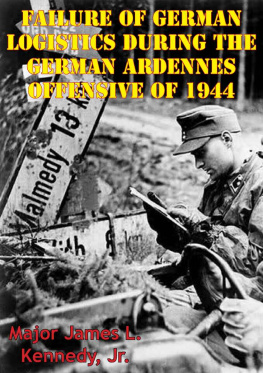

This edition is published by PICKLE PARTNERS PUBLISHINGwww.picklepartnerspublishing.com
To join our mailing list for new titles or for issues with our books picklepublishing@gmail.com
Or on Facebook
Text originally published in 2007 under the same title.
Pickle Partners Publishing 2014, all rights reserved. No part of this publication may be reproduced, stored in a retrieval system or transmitted by any means, electrical, mechanical or otherwise without the written permission of the copyright holder.
Publishers Note
Although in most cases we have retained the Authors original spelling and grammar to authentically reproduce the work of the Author and the original intent of such material, some additional notes and clarifications have been added for the modern readers benefit.
We have also made every effort to include all maps and illustrations of the original edition the limitations of formatting do not allow of including larger maps, we will upload as many of these maps as possible.
THE FAILURE OF GERMAN LOGISTICS DURING THE GERMAN ARDENNES OFFENSIVE OF 1944
By
MAJ James L. Kennedy, Jr., USA
TABLE OF CONTENTS
Contents
ABSTRACT
This study investigates the role that logistics played in the failure of the German Offensive in the Ardennes in 1944. The thesis explains that despite the incredible build-up of forces and supplies, the inability of the German strategic and operational logistics systems to properly equip, fuel, arm, and move forces caused the failure of the Ardennes Offensive.
The concept of this thesis starts with the overall strategic military and political situation of Germany in the fall of 1944 that Hitler used to base his decision to conduct the offensive in December 1944.
The study then examines in detail the strategic capabilities during the build-up of supplies and the operational level organization and planning for the offensive. An analysis of the details on the impact of terrain, climate, allied air interdiction, and Operation Point Blank is included in this chapter.
Then it examines the first weeks of the offensive and looks at the failure of the fuel and arm and move tactical logistics functions. An analysis of the impact of logistics on supporting operations is included in this chapter.
ACKNOWLEDGMENTS
First and most important, I want to thank my wife, Kim, and daughter, Jamie Ann, for allowing me to work on this thesis. This thesis and degree have been a goal for me for many years. They sacrificed family time to allow me to complete this research and degree. This thesis is dedicated to my father that instilled the love of military history in me and to my daughter for whom I do my job to prevent wars so that she may grow up in peaceful times. I also wish to express my appreciation to the historians and others that wrote and continue to write about the greatest American victory of World War II. Finally, I want to thank the research staff of the Combined Arms Research Library at Fort Leavenworth, especially Rusty Rafferty and John Rogers. They were professional, helpful, and resourceful and provided information in a timely manner. I would have never been able to retrieve and sift through the mountain of historical documents without their continuous assistance.
LIST OF TABLES
1. Raw materials provided by other nations and their use in war materials.
2. Reorganization of Panzer Divisions for Ardennes Offensive.
3. Planned versus Available Forces for the Ardennes Offensive.
4. Allocation of Division at Start of Offensive.
5. Time Line for Movement of Units into the Ardennes Area.
LIST OF ILLUSTRATION
1. German Order of Battle.
CHAPTER 1 OVERVIEW OF THE GERMAN STRATEGIC SITUATION
On 16 December 1944, Hitler launched a massive attack through the Ardennes with three armies and twenty-five divisions. This attack quickly stalled and failed to meet any of the objectives set forth for success. Historians have cited many reasons for the failure of the offensive: a staunch defense by American individuals and units, Lieutenant General George Pattons rapid northward movement of the Third US Army to attack the southern flank of the German forces, Allied airpower, weather and terrain, and Allied leadership. However, the foundation of the failure started months before the 16 December surprise attack. Since that fateful day, historians have tended to overshadow the critical role of logistics in influencing the outcome of one of World War Twos greatest battles. The intent of this thesis is to show the critical and decisive role that the failures in German logistics played in their defeat in the Ardennes. This thesis will illustrate that the failure of the German strategic and operational logistics system to properly equip, arm, fuel, and move German forces had the most direct influence on the failure of the 1944 Ardennes Offensive.
Section 1. German Military and Political Situation
By the fall of 1944, Hitlers five-year military grip on Europe was in a significantly different situation that it was at the beginning of the year. Since the start of the year, Germany had suffered many military defeats and political setbacks. On the Western Front, the Americans and British armys had landed in June at Normandy and established a beachhead in Fortress Europe. Meanwhile, Rome fell to the Allies and the Germans had fallen back to the Gothic Line in Italy. By the end of July the Americans had broken through at Avaranches and throughout August, Germans were retreating across France toward Germany. Allied forces all but destroyed the best German units on the Western Front in the Falaise Pocket. Also in July, German industrial production began to decline as a result of the Allied strategic bombing campaign. In August, the Allies had invaded Southern France and were rapidly advancing up the Rhone Valley. Additionally, over 230,000 Germans were surrounded in the West. Despite the similar organizations, the Allied divisions were in a much better state of readiness than the German divisions. German infantry and armored divisions, disorganized during the retreat, were in various states of readiness.
On the Eastern Front, the situation was even worse. The Soviet summer offensive had run its course by the end of July and the results were devastating for Germany. Operation Bagration decimated two German Armiesforcing one-third of the German forces to retreat and causing the loss of over 350,000 German troops and 900 tanks.
In contrast to the overall military situation, Germanys manpower was in a better condition. From 1938 through 1943, the Wehrmacht mobilized over eleven million men. Losses for the same period totaled over six million killed, captured, wounded, or missing
In September 1944, Germanys military totaled 327 divisions and separate brigades including thirty-one armored divisions and armored separate brigades spread over both fronts. While this is an impressive number of divisions, many of these units did not exist but were still on the official records. Other units were so decimated they were essentially combated ineffective. The total manpower was over ten million officers and men in the Wehrmacht at the beginning of September.
Despite the large number of divisions reported, the low strength of troops in these units concerned Hitler. To resolve the personnel readiness problems, Hitler appointed Heinrich Himmler as Chief of the Replacement Army. Himmler developed programs to purge staff offices, consolidate combat ineffective units, and transfer troops from the Luftwaffe and Navy. Some other measures Himmler implemented were activating soldiers who were deferred for medical reasons and placing them in special units to man the Siegfried Line. He also took these newly activated soldiers and used them in jobs that were not directly combat related to allowable combat troops to be sent to front line units. Finally, the age limit for volunteers dropped from age eighteen to age sixteen while the oldest age increased from fifty-eight to sixty. To promote party unity and make the plan acceptable to the public, Reich Minister Joseph Goebbels announced new mobilization measures. Goebbels closed schools and theaters, increased the work week from forty to sixty hours, temporarily abolished holidays, closed small shops of many types, and denuded the staffs of government bureaus. All of these measures enabled Himmler to create eighteen new divisions, ten separate brigades and nearly one-hundred separate battalions. These new units were fielded to fronts as necessary. The low manpower situation in divisions was upgraded by taking soldiers from low-strength divisions and sending them to another division while maintaining the hollow division on the books.
Next page


















